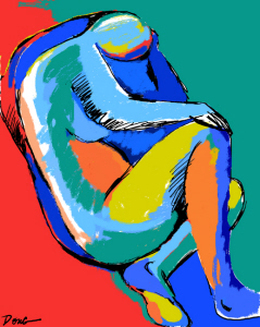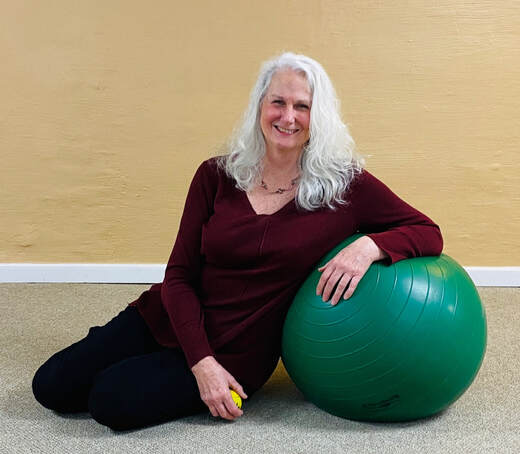Feldenkrais Awareness Through Movement®
(ATM) Classes
taught by Denise Deig, GCFP
No IN PERSON Classes are scheduled
in Indianapolis at this time.
Lung Health & Pneumonia Prevention
Denise's Free Videos on Vimeo
9 Videos are online Now
You will find some ATM Lessons in Videos #1 (Breath Awareness), #2
(Diaphagmatic Pump), #3 (Soft Roller Movement Supine), #4 (Diagonal
Pump), & #6 (Gym Ball & Soft Roller Movements)
Please Enjoy!
https://vimeo.com/user112333430
"My fundamental contention is that the unity of mind and body is an objective reality; that these entities are not related to each other in one fashion of another, but are an inseparable whole."
Moshe Feldenkrais
Neurodifferentiation is a key stage of Neuroplastic healing
Doidge notes that Differentiation is making minute sensory distinctions between movements, which results in building brain maps of underused sensory & motor regions. He suggests ATM Classes as a viable method of enhancing Neurodifferentiation.
The following quotes by Norman Doidge, MD are from "A Brain's Way of Healing"
"Slower movement lends to more subtle observation and map differentiation, so that more change is possible."
Page 173
"Slowness of movement is the key to awareness, and awareness is the key to learning."
Page 172
Moshe Feldenkrais
Neurodifferentiation is a key stage of Neuroplastic healing
Doidge notes that Differentiation is making minute sensory distinctions between movements, which results in building brain maps of underused sensory & motor regions. He suggests ATM Classes as a viable method of enhancing Neurodifferentiation.
The following quotes by Norman Doidge, MD are from "A Brain's Way of Healing"
"Slower movement lends to more subtle observation and map differentiation, so that more change is possible."
Page 173
"Slowness of movement is the key to awareness, and awareness is the key to learning."
Page 172

Description of ATM Lessons by Moshe Feldenkrais,
"Embodied Wisdom", Chapter 6, Pages 72-73:
"To begin with, the lessons take place in the lying position, prone or supine, to facilitate the breaking down of muscular patterns. The habitual pressures on the soles of the feet and the ensuing configuration of the skeletal joints are suppressed. The nervous system does not receive the habitual afferent stimuli due to gravitation, and the efferent impulses are not linked into the habitual patterns. After the lessons, on receiving again the habitual stimuli, one is surprised to discover a changed response to them.
The lessons are done as slowly and pleasantly as possible, with no strain or pain whatsoever; the main object is not to receive training in what one knows, but to discover unknown reactions in oneself and thereby learn a better, more congenial way of acting.
The movements are light, so that after fifteen or twenty repetitions the initial effort drops to practically nothing more than a thought. This produces the maximum sensitivity in the person and enables him to detect the minute changes in the efferent tonus and the change in alignment of the different parts of the body. By the end of the lessons, one feels that his body is hanging lightly from his head, his feet do not stamp on the ground, and his body glides when moving.
The head, which carries all the teleceptors---eyes, ears, nostrils, and mouth---and which turns right and left in almost every movement, attending to changes in the space around us, should turn with a smoothness unequaled by the most perfect man-made mechanism. Of all the teleceptors, the eyes also move right and left, relative to the head, and their movement in the direction of the head's rotation or opposite to it should be gliding and easy."
"Embodied Wisdom", Chapter 6, Pages 72-73:
"To begin with, the lessons take place in the lying position, prone or supine, to facilitate the breaking down of muscular patterns. The habitual pressures on the soles of the feet and the ensuing configuration of the skeletal joints are suppressed. The nervous system does not receive the habitual afferent stimuli due to gravitation, and the efferent impulses are not linked into the habitual patterns. After the lessons, on receiving again the habitual stimuli, one is surprised to discover a changed response to them.
The lessons are done as slowly and pleasantly as possible, with no strain or pain whatsoever; the main object is not to receive training in what one knows, but to discover unknown reactions in oneself and thereby learn a better, more congenial way of acting.
The movements are light, so that after fifteen or twenty repetitions the initial effort drops to practically nothing more than a thought. This produces the maximum sensitivity in the person and enables him to detect the minute changes in the efferent tonus and the change in alignment of the different parts of the body. By the end of the lessons, one feels that his body is hanging lightly from his head, his feet do not stamp on the ground, and his body glides when moving.
The head, which carries all the teleceptors---eyes, ears, nostrils, and mouth---and which turns right and left in almost every movement, attending to changes in the space around us, should turn with a smoothness unequaled by the most perfect man-made mechanism. Of all the teleceptors, the eyes also move right and left, relative to the head, and their movement in the direction of the head's rotation or opposite to it should be gliding and easy."

